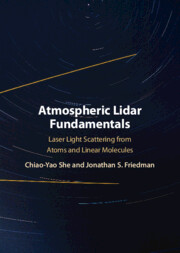Book contents
- Atmospheric Lidar Fundamentals
- Atmospheric Lidar Fundamentals
- Copyright page
- Dedication
- Contents
- Foreword
- Preface
- 1 Introduction
- 2 Classical Light Scattering Theory
- 3 Semiclassical Treatment of Light Absorption and Scattering from Atoms
- 4 Rayleigh and Raman Scattering from Linear Molecules
- 5 Introduction to Lidar Remote Sensing and the Lidar Equation
- 6 Common (Broadband) Lidar Types and Associated Applications
- 7 Lidars for Profiling Aerosol Optical Properties, Atmospheric Temperature and Wind
- 8 Transmitting and Receiving Optics
- Book part
- Index
- References
7 - Lidars for Profiling Aerosol Optical Properties, Atmospheric Temperature and Wind
Published online by Cambridge University Press: 24 February 2022
- Atmospheric Lidar Fundamentals
- Atmospheric Lidar Fundamentals
- Copyright page
- Dedication
- Contents
- Foreword
- Preface
- 1 Introduction
- 2 Classical Light Scattering Theory
- 3 Semiclassical Treatment of Light Absorption and Scattering from Atoms
- 4 Rayleigh and Raman Scattering from Linear Molecules
- 5 Introduction to Lidar Remote Sensing and the Lidar Equation
- 6 Common (Broadband) Lidar Types and Associated Applications
- 7 Lidars for Profiling Aerosol Optical Properties, Atmospheric Temperature and Wind
- 8 Transmitting and Receiving Optics
- Book part
- Index
- References
Summary
In Chapter 7, we present lidars for profiling atmospheric parameters such as aerosol optical properties, temperatures, and winds. We start with a description of methods for profiling the lidar aerosol-molecular ratio and determining aerosol optical properties. We present and compare techniques for these measurements, including Rayleigh and vibrational Raman integration, rotational Raman technique, and the use of multiple receiver channels with custom-built interference filters. We follow with a description of high-spectral resolution lidar (HSRL), including a detailed discussion of notch (atomic or molecular vapor) filters in the Cabannes scattering detection channels and what is required to make an “ideal” or near-ideal filter. From there, we describe wind profiling methods using Cabannes–Mie scattering, comparing coherent versus incoherent lidars. For HSRL, we describe a near-ideal filter based on absorption in potassium vapor at 770 nm. Following parameter profiling with Cabannes–Mie lidar, we close by describing temperature and wind profiling with laser-induced fluorescence. Here, we focus on Na and Fe lidars. We give summaries of daylight measurements and data processing algorithms, including uncertainty in measurements. We close by discussing scientific contributions by and challenges for these lidars.
Keywords
Information
- Type
- Chapter
- Information
- Atmospheric Lidar FundamentalsLaser Light Scattering from Atoms and Linear Molecules, pp. 138 - 243Publisher: Cambridge University PressPrint publication year: 2022
